第四章TheMeaningsandDimensionsofCulture文化的内涵与维度国际企业与跨文化管理课件
- 格式:ppt
- 大小:676.00 KB
- 文档页数:41
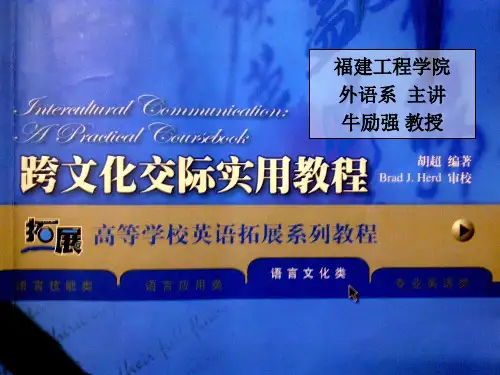
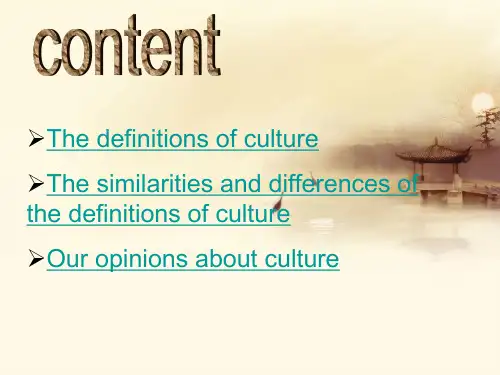


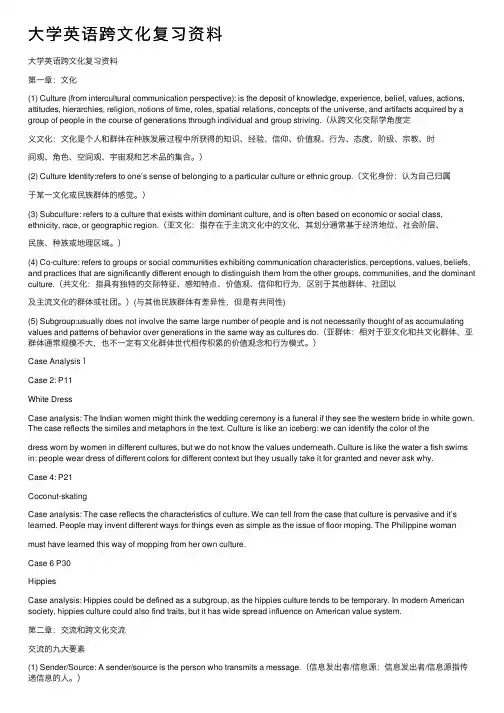
⼤学英语跨⽂化复习资料⼤学英语跨⽂化复习资料第⼀章:⽂化(1) Culture (from intercultural communication perspective): is the deposit of knowledge, experience, belief, values, actions, attitudes, hierarchies, religion, notions of time, roles, spatial relations, concepts of the universe, and artifacts acquired by a group of people in the course of generations through individual and group striving.(从跨⽂化交际学⾓度定义⽂化:⽂化是个⼈和群体在种族发展过程中所获得的知识、经验、信仰、价值观、⾏为、态度、阶级、宗教、时间观、⾓⾊、空间观、宇宙观和艺术品的集合。
)(2) Culture Identity:refers to one’s sense of belonging to a particular culture or ethnic group.(⽂化⾝份:认为⾃⼰归属于某⼀⽂化或民族群体的感觉。
)(3) Subculture: refers to a culture that exists within dominant culture, and is often based on economic or social class, ethnicity, race, or geographic region.(亚⽂化:指存在于主流⽂化中的⽂化,其划分通常基于经济地位、社会阶层、民族、种族或地理区域。
)(4) Co-culture: refers to groups or social communities exhibiting communication characteristics, perceptions, values, beliefs, and practices that are significantly different enough to distinguish them from the other groups, communities, and the dominant culture.(共⽂化:指具有独特的交际特征、感知特点、价值观、信仰和⾏为,区别于其他群体、社团以及主流⽂化的群体或社团。
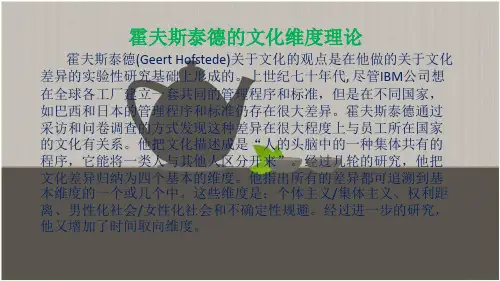

新概念英语第四册文化内涵知识点:Patterns of culture这篇课文是关于文化研究的学术文章,是新四课文中难度的。
文化研究在西方的社会科学研究中占有重要的地位。
文化研究主要是由社会学家、人类学家进行的,但由于文化的影响无处不在,心理学系、语言学系等学科也有相关的文化研究。
尽管作者是专业的文化学家,但我们会发现,课文中并没有给出“文化”一词明确的定义。
这是因为,“文化”包罗万象,很难给出令人满意的定义。
学者RaymondWilliams认为,culture是英语中最复杂的两三个词之一。
简单来说,文化就是“风俗”,包括我们所有的社会活动,比如语言、婚嫁、礼仪、艺术等。
要透彻地理解本文,我们就必须对作者Ruth Benedict的学术立场有所了解。
Ruth Benedict被认为是20世纪秀的人类学家之一,她在文化研究上的立场是“文化相对主义”(culturalrelativism)。
文化相对主义者的观点是:研究某个社团的文化必须考虑这个社团特有的背景,文化只有相对的差异,而没有优劣之分。
了解了这一点,我们就能明白为什么课文中作者在详细论述了文化研究的重要性之后,又笔锋一转,讲到文化的研究方法。
作者在课文最后指出,如果文化研究只考察西方的文明,那就不是真正的科学研究,这正是作者文化相对主义的体现:各文化都是平等的,研究文化不应该有偏见。
这样,我们就会体会到,这部分才是课文最重要的一部分。
课文的第一段的最后一句话是:The fact of first-rate importance is the predominant role thatcustom plays in experience and in belief, and the great varieties it maymanifest.这句话是强调文化的重要性,我们在阅读时经常会不注意“varieties”这个单词,而其实这个单词也是课文的一个文眼:作者是文化相对主义者,文化有多样性的,文化不仅仅是西方文化。

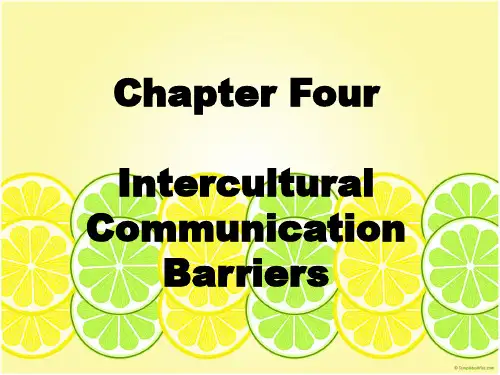
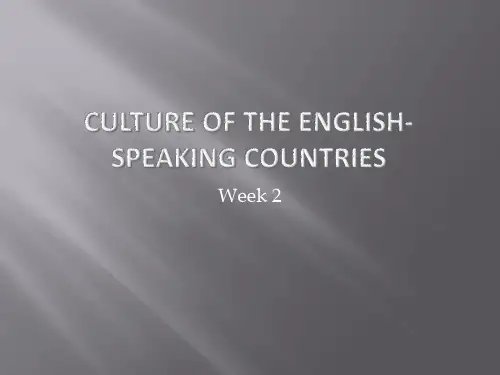

胡壮麟《语言学教程》(修订版)测试题第一章:语言学导论I. Choose the best answer. (20%)1. Language is a system of arbitrary vocal symbols used for human __________.A. contactB. communicationC. relationD. community2. Which of the following words is entirely arbitrary?A. treeB. typewriterC. crashD. bang3. The function of the sentence “Water boils at 100 degrees Centigrade.” is __________.A. interrogativeB. directiveC. informativeD. performative4. In Chinese when someone breaks a bowl or a plate the host or the people present are likely to say“碎碎(岁岁)平安”as a means of controlling the forces which they believes feel might affect their lives. Which functions does it perform?A. InterpersonalB. EmotiveC. PerformativeD. Recreational5. Which of the following property of language enables language users to overcome the barriers caused by time and place, due to this feature of language, speakers of a language are free to talk about anything in any situation?A. TransferabilityB. DualityC. DisplacementD. Arbitrariness6. Study the following dialogue. What function does it play according to the functions of language?—A nice day, isn’t it?— Right! I really enjoy the sunlight.A. EmotiveB. PhaticC. PerformativeD. Interpersonal7. __________ refers to the actual realization of the ideal language user’s knowledge of the rules of his language in utterances.A. PerformanceB. CompetenceC. LangueD. Parole8. When a dog is barking, you assume it is barking for something or at someone that exists hear and now.It couldn’t be sorrowful for some lost love or lost bone. This indicates the design feature of __________.A. cultural transmissionB. productivityC. displacementD. duality9. __________ answers such questions as how we as infants acquire our first language.A. PsycholinguisticsB. Anthropological linguisticsC. SociolinguisticsD. Applied linguistics10. __________ deals with language application to other fields, particularly education.A. Linguistic theoryB. Practical linguisticsC. Applied linguisticsD. Comparative linguisticsII. Decide whether the following statements are true or false. (10%) 11. Language is a means of verbal communication. Therefore, the communication way used by the deaf-mute is not language.12. Language change is universal, ongoing and arbitrary.13. Speaking is the quickest and most efficient way of the human communication systems.14. Language is written because writing is the primary medium for all languages.15. We were all born with the ability to acquire language, which means the details of any language system can be genetically transmitted.16. Only human beings are able to communicate.17. . De Saussure, who made the distinction between langue and parole in the early 20th century, was a French linguist.18. A study of the features of the English used in Shakespeare’s time is an example of the diachronic study of language.19.Speech and writing came into being at much the same time in human history.20. All the languages in the world today have both spoken and written forms.III. Fill in the blanks. (10%)21. Language, broadly speaking, is a means of __________ communication.22. In any language words can be used in new ways to mean new things and can be combined into innumerable sentences based on limited rules. This feature is usually termed __________.23. Language has many functions. We can use language to talk about itself. This function is __________.24. Theory that primitive man made involuntary vocal noises while performing heavy work has been called the __________ theory.25. Linguistics is the __________ study of language.26. Modern linguistics is __________ in the sense that the linguist tries to discover what language is rather than lay down some rules for people to observe.27. One general principle of linguistic analysis is the primacy of __________ over writing.28.The description of a language as it changes through time is a __________ study.29.Saussure put forward two important concepts. __________ refers to the abstract linguistic system shared by all members of a speech community.30. Linguistic potential is similar to Saussure’s langue and Chomsky’s __________. IV. Explain the following terms, using examples. (20%)31. Design feature32. Displacement33. Competence34.Synchronic linguisticsV. Answer the following questions. (20%)35.Why do people take duality as one of the important design features of human language? Can you tell us what language will be if it has no such design feature?(南开大学,2004)36.Why is it difficult to define language? (北京第二外国语大学,2004)VI. Analyze the following situation. (20%)37. How can a linguist make his analysis scientific? (青岛海洋大学,1999)第二章:语音I. Choose the best answer. (20%)1. Pitch variation is known as __________ when its patterns are imposed on sentences.A. intonationB. toneC. pronunciationD. voice2. Conventionally a __________ is put in slashes (/ /).A. allophoneB. phoneC. phonemeD. morpheme3. An aspirated p, an unaspirated p and an unreleased p are __________ of the p phoneme.A. analoguesB. tagmemesC. morphemesD. allophones4. The opening between the vocal cords is sometimes referred to as __________.A. glottisB. vocal cavityC. pharynxD. uvula5. The diphthongs that are made with a movement of the tongue towards the center are known as __________ diphthongs.A. wideB. closingC. narrowD. centering6. A phoneme is a group of similar sounds called __________.A. minimal pairsB. allomorphsC. phonesD. allophones7. Which branch of phonetics concerns the production of speech sounds?A. Acoustic phoneticsB. Articulatory phoneticsC. Auditory phoneticsD. None of the above8. Which one is different from the others according to places of articulation?A. [n]B. [m]C. [ b ]D. [p]9. Which vowel is different from the others according to the characteristics of vowels?A. [i:]B. [ u ]C. [e]D. [ i ]10. What kind of sounds can we make when the vocal cords are vibrating?A. VoicelessB. VoicedC. Glottal stopD. ConsonantII. Decide whether the following statements are true or false. (10%) 11. Suprasegmental phonology refers to the study of phonological properties of units larger than the segment-phoneme, such as syllable, word and sentence.12. The air stream provided by the lungs has to undergo a number of modification to acquire the quality of a speech sound.13. Two sounds are in free variation when they occur in the same environment and do not contrast, namely,the substitution of one for the other does not produce a different word, but merely a different pronunciation.14. [p] is a voiced bilabial stop.15. Acoustic phonetics is concerned with the perception of speech sounds.16. All syllables must have a nucleus but not all syllables contain an onset and a coda.17. When pure vowels or monophthongs are pronounced, no vowel glides take place.18. According to the length or tenseness of the pronunciation, vowels can be divided into tense vs. lax or long vs. short.19. Received Pronunciation is the pronunciation accepted by most people.20. The maximal onset principle states that when there is a choice as to where to placea consonant, it is put into the coda rather than the onset.III. Fill in the blanks. (20%)21. Consonant sounds can be either __________ or __________, while all vowel sounds are __________.22. Consonant sounds can also be made when two organs of speech in the mouth are brought close together so that the air is pushed out between them, causing__________.23. The qualities of vowels depend upon the position of the __________ and the lips.24. One element in the description of vowels is the part of the tongue which is at the highest point in the mouth. A second element is the __________ to which that part of the tongue is raised.25. Consonants differ from vowels in that the latter are produced without__________.26.In phonological analysis the words fail / veil are distinguishable simply because of the two phonemes /f/ - /v/. This is an example for illustrating __________.27. In English there are a number of __________, which are produced by moving from one vowel position to another through intervening positions.28. __________ refers to the phenomenon of sounds continually show the influence of their neighbors.29. __________ is the smallest linguistic unit.30. Speech takes place when the organs of speech move to produce patterns of sound. These movements have an effect on the __________ coming from the lungs.IV. Explain the following terms, using examples. (20%)31. Sound assimilation32. Suprasegmental feature33. Complementary distribution34. Distinctive featuresV. Answer the following questions. (20%)35. What is acoustic phonetics?(中国人民大学,2003)36. What are the differences between voiced sounds and voiceless sounds in terms of articulation?(南开04)VI. Analyze the following situation. (20%)37. Write the symbol that corresponds to each of the following phonetic descriptions; then give an English word that contains this sound. Example: voiced alveolar stop [d] dog. (青岛海洋大学,1999)(1) voiceless bilabial unaspirated stop(2) low front vowel(3) lateral liquid(4) velar nasal(5) voiced interdental fricative第三章:词汇I. Choose the best answer. (20%)1. Nouns, verbs and adjectives can be classified as __________.A. lexical wordsB. grammatical wordsC. function wordsD. form words2. Morphemes that represent tense, number, gender and case are called __________ morpheme.A. inflectionalB. freeC. boundD. derivational3. There are __________ morphemes in the word denationalization.A. threeB. fourC. fiveD. six4. In English –ise and –tion are called __________.A. prefixesB. suffixesC. infixesD. stems5. The three subtypes of affixes are: prefix, suffix and __________.A. derivational affixB. inflectional affixC. infixD. back-formation6. __________ is a way in which new words may be formed from already existing words by subtracting an affix which is thought to be part of the old word.A. affixationB. back-formationC. insertionD. addition7. The word TB is formed in the way of __________.A. acronymyB. clippingC. initialismD. blending8. The words like comsat and sitcom are formed by __________.A. blendingB. clippingC. back-formationD. acronymy9. The stem of disagreements is __________A. agreementB. agreeC. disagreeD. disagreement10. All of them are meaningful except for __________.A. lexemeB. phonemeC. morphemeD. allomorphII. Decide whether the following statements are true or false. (10%) 11. Phonetically, the stress of a compound always falls on the first element, while the second element receives secondary stress.12. Fore as in foretell is both a prefix and a bound morpheme.13. Base refers to the part of the word that remains when all inflectional affixes are removed.14. In most cases, prefixes change the meaning of the base whereas suffixes change the word-class of the base.15. Conversion from noun to verb is the most productive process of a word.16. Reduplicative compound is formed by repeating the same morpheme of a word.17. The words whimper, whisper and whistle are formed in the way of onomatopoeia.18. In most cases, the number of syllables of a word corresponds to the number of morphemes.19. Back-formation is a productive way of word-formations.20. Inflection is a particular way of word-formations.III. Fill in the blanks. (20%)21. An __________ is pronounced letter by letter, while an __________ is pronounced as a word.22. Lexicon, in most cases, is synonymous with __________.23. Orthographically, compounds are written in three ways: __________, __________ and __________.24. All words may be said to contain a root __________.25. A small set of conjunctions, prepositions and pronouns belong to __________ class, while the largest part of nouns, verbs, adjectives and adverbs belongs to__________ class.26. __________ is a reverse process of derivation, and therefore is a process of shortening.27. __________ is extremely productive, because English had lost most of its inflectional endings by the end of Middle English period, which facilitated the use of words interchangeably as verbs or nouns, verbs or adjectives, and vice versa.28. Words are divided into simple, compound and derived words on the __________ level.29. A word formed by derivation is called a __________, and a word formed by compounding is called a__________.30. Bound morphemes are classified into two types: __________ and __________. IV. Explain the following terms, using examples. (20%)31. Blending32. Allomorph33. Closed-class word34. Morphological ruleV. Answer the following questions. (20%)35. How many types of morphemes are there in the English language? What are they? (厦门大学,2003)36. What are the main features of the English compounds?VI. Analyze the following situation. (20%)37. Match the terms under COLUMN I with the underlined forms from COLUMN II (武汉大学,2004)I II(1) acronym a. foe(2) free morpheme b. subconscious(3) derivational morpheme c. UNESCO(4) inflectional morpheme d. overwhelmed(5) prefix e. calculation第四章:句法I. Choose the best answer. (20%)1. The sentence structure is ________.A. only linearB. only hierarchicalC. complexD. both linear and hierarchical2. The syntactic rules of any language are ____ in number.A. largeB. smallC. finiteD. infinite3. The ________ rules are the rules that group words and phrases to form grammatical sentences.A. lexicalB. morphologicalC. linguisticD. combinational4. A sentence is considered ____ when it does not conform to the grammatical knowledge in the mind of native speakers.A. rightB. wrongC. grammaticalD. ungrammatical5. A __________ in the embedded clause refers to the introductory word that introduces the embedded clause.A. coordinatorB. particleC. prepositionD. subordinator6. Phrase structure rules have ____ properties.A. recursiveB. grammaticalC. socialD. functional7. Phrase structure rules allow us to better understand _____________.A. how words and phrases form sentences.B. what constitutes the grammaticality of strings of wordsC. how people produce and recognize possible sentencesD. all of the above.8. The head of the phrase “the city Rome” is __________.A. the cityB. RomeC. cityD. the city Rome9. The phrase “on the shelf” be longs to __________ construction.A. endocentricB. exocentricC. subordinateD. coordinate10. The sentence “They were wanted to remain quiet and not to expose themselves.” is a __________sentence.A. simpleB. coordinateC. compoundD. complexII. Decide whether the following statements are true or false. (10%) 11. Universally found in the grammars of all human languages, syntactic rules that comprise the system of internalized linguistic knowledge of a language speaker are known as linguistic competence.12. The syntactic rules of any language are finite in number, but there is no limit to the number of sentences native speakers of that language are able to produce and comprehend.13. In a complex sentence, the two clauses hold unequal status, one subordinating the other.14. Constituents that can be substituted for one another without loss of grammaticality belong to the same syntactic category.15. Minor lexical categories are open because these categories are not fixed and new members are allowed for.16. In English syntactic analysis, four phrasal categories are commonly recognized and discussed, namely, noun phrase, verb phrase, infinitive phrase, and auxiliary phrase.17. In English the subject usually precedes the verb and the direct object usually follows the verb.18. What is actually internalized in the mind of a native speaker is a complete list of words and phrases rather than grammatical knowledge.19. A noun phrase must contain a noun, but other elements are optional.20. It is believed that phrase structure rules, with the insertion of the lexicon, generate sentences at the level of D-structure.III. Fill in the blanks. (20%)21. A __________ sentence consists of a single clause which contains a subject and a predicate and stands alone as its own sentence.22. A __________ is a structurally independent unit that usually comprises a number of words to form a complete statement, question or command.23. A __________ may be a noun or a noun phrase in a sentence that usually precedes the predicate.24. The part of a sentence which comprises a finite verb or a verb phrase and which says something about the subject is grammatically called __________.25. A __________ sentence contains two, or more, clauses, one of which is incorporated into the other.26. In the complex sentence, the incorporated or subordinate clause is normally called an __________clause.27. Major lexical categories are __________ categories in the sense that new words are constantly added.28. __________ condition on case assignment states that a case assignor and a case recipient should stay adjacent to each other.29. __________ are syntactic options of UG that allow general principles to operate in one way or another and contribute to significant linguistic variations between andamong natural languages.30. The theory of __________ condition explains the fact that noun phrases appear only in subject and object positions.IV. Explain the following terms, using examples. (20%)31. Syntax32. IC analysis33. Hierarchical structure34. Trace theoryV. Answer the following questions. (20%)35. What are endocentric construction and exocentric construction? (武汉大学,2004)36. Distinguish the two possible meanings of “more beautiful flowers” by means of IC analysis. (北京二外国语大学,2004)VI. Analyze the following situation. (20%)37. Draw a tree diagram according to the PS rules to show the deep structure of the sentence:The student wrote a letter yesterday.第五章:意义I. Choose the best answer. (20%)1. The naming theory is advanced by ________.A. PlatoB. BloomfieldC. Geoffrey LeechD. Firth2.“We shall know a word by the company it keeps.” This statement represents_______.A. the conceptualist viewB. contexutalismC. the naming theoryD. behaviorism3. Which of the following is NOT true?A. Sense is concerned with the inherent meaning of the linguistic form.B. Sense is the collection of all the features of the linguistic form.C. Sense is abstract and decontextualized.D. Sense is the aspect of meaning dictionary compilers are not interested in.4. “Can I borrow your bike?”_______ “You have a bike.”A. is synonymous withB. is inconsistent withC. entailsD. presupposes5. ___________ is a way in which the meaning of a word can be dissected into meaning components,called semantic features.A. Predication analysisB. Componential analysisC. Phonemic analysisD. Grammatical analysis6. “Alive” and “dead” are ______________.A. gradable antonymsB. relational antonymsC. complementary antonymsD. None of the above7. _________ deals with the relationship between the linguistic element and thenon-linguistic world of experience.A. ReferenceB. ConceptC. SemanticsD. Sense8. ___________ refers to the phenomenon that words having different meanings have the same form.A. PolysemyB. SynonymyC. HomonymyD. Hyponymy9. Words that are close in meaning are called ______________.A. homonymsB. polysemiesC. hyponymsD. synonyms10. The grammaticality of a sentence is governed by _______.A. grammatical rulesB. selectional restrictionsC. semantic rulesD. semantic featuresII. Decide whether the following statements are true or false. (10%) 11. Dialectal synonyms can often be found in different regional dialects such as British English and American English but cannot be found within the variety itself, for example, within British English or American English.12. Sense is concerned with the relationship between the linguistic element and the non-linguistic world of experience, while the reference deals with the inherent meaning of the linguistic form.13. Linguistic forms having the same sense may have different references in different situations.14. In semantics, meaning of language is considered as the intrinsic and inherent relation to the physical world of experience.15. Contextualism is based on the presumption that one can derive meaning from or reduce meaning to observable contexts.16. Behaviorists attempted to define the meaning of a language form as the situation in which the speaker utters it and the response it calls forth in the hearer.17. The meaning of a sentence is the sum total of the meanings of all its components.18. Most languages have sets of lexical items similar in meaning but ranked differently according to their degree of formality.19. “It is hot.” is a no-place predication because it contains no argument.20. In grammatical analysis, the sentence is taken to be the basic unit, but in semantic analysis of a sentence, the basic unit is predication, which is the abstraction of the meaning of a sentence.III. Fill in the blanks. (20%)21. __________ can be defined as the study of meaning.22. The conceptualist view holds that there is no __________ link between a linguistic form and what it refers to.23. __________ means what a linguistic form refers to in the real, physical world; it deals with the relationship between the linguistic element and the non-linguistic world of experience.24. Words that are close in meaning are called __________.25. When two words are identical in sound, but different in spelling and meaning, they are called__________.26. __________ opposites are pairs of words that exhibit the reversal of a relationship between the two items.27. __________ analysis is based upon the belief that the meaning of a word can be divided into meaning components.28. Whether a sentence is semantically meaningful is governed by rules called__________ restrictions, which are constraints on what lexical items can go with what others.29. A(n) __________ is a logical participant in a predication, largely identical with the nominal element(s)in a sentence.30. According to the __________ theory of meaning, the words in a language are taken to be labels of the objects they stand for.IV. Explain the following terms, using examples. (20%)31. Entailment32. Proposition33. Componential analysis34. ReferenceV. Answer the following questions. (20%)35. What are the sense relations between the following groups of words?Dogs, cats, pets, parrots; trunk, branches, tree, roots (青岛海洋大学,1999)36. What are the three kinds of antonymy? (武汉大学,2004)VI. Analyze the following situation. (20%)37. For each group of words given below, state what semantic property or properties are shared by the (a) words and the (b) words, and what semantic property or properties distinguish between the classes of (a)words and (b) words.(1) a. bachelor, man, son, paperboy, pope, chiefb. bull, rooster, drake, ram(2) a. table, stone, pencil, cup, house, ship, carb. milk, alcohol, rice, soup(3) a. book, temple, mountain, road, tractorb. idea, love, charity, sincerity, bravery, fear (青岛海洋大学,1999)第七章:语言、文化和社会[注:第六章无测试题]I. Choose the best answer. (20%)1. _______ is concerned with the social significance of language variation and language use in different speech communities.A. PsycholinguisticsB. SociolinguisticsC. Applied linguisticsD. General linguistics2. The most distinguishable linguistic feature of a regional dialect is its __________.A. use of wordsB. use of structuresC. accentD. morphemes3. __________ is speech variation according to the particular area where a speaker comes from.A. Regional variationB. Language variationC. Social variationD. Register variation4. _______ are the major source of regional variation of language.A. Geographical barriersB. Loyalty to and confidence in one’s native speechC. Physical discomfort and psychological resistance to changeD. Social barriers5. _________ means that certain authorities, such as the government choose, a particular speech variety, standardize it and spread the use of it across regional boundaries.A. Language interferenceB. Language changesC. Language planningD. Language transfer6._________ in a person’s speech or writing usually ranges on a continuu m from casual or colloquial to formal or polite according to the type of communicative situation.A. Regional variationB. Changes in emotionsC. Variation in connotationsD. Stylistic variation7. A ____ is a variety of language that serves as a medium of communication among groups of people for diverse linguistic backgrounds.A. lingua francaB. registerC. CreoleD. national language8.Although _______ are simplified languages with reduced grammatical features, they are rule-governed, like any human language.A. vernacular languagesB. creolesC. pidginsD. sociolects9. In normal situations, ____ speakers tend to use more prestigious forms than their____ counterparts with the same social background.A. female; maleB. male; femaleC. old; youngD. young; old10. A linguistic _______ refers to a word or expression that is prohibited by the “polite” society from general use.A. slangB. euphemismC. jargonD. tabooII. Decide whether the following statements are true or false. (10%) 11. Language as a means of social communication is a homogeneous system with a homogeneous group of speakers.12. The goal of sociolinguistics is to explore the nature of language variation and language use among a variety of speech communities and in different social situations.13. From the sociolinguistic perspective, the term “speech variety” can n ot be used to refer to standard language, vernacular language, dialect or pidgin.14. The most distinguishable linguistic feature of a regional dialect is its grammar and uses of vocabulary.15. A person’s social backgrounds do not exert a shaping influence on his choice of linguistic features.16. Every speaker of a language is, in a stricter sense, a speaker of a distinct idiolect.17. A lingua franca can only be used within a particular country for communication among groups of people with different linguistic backgrounds.18. A pidgin usually reflects the influence of the higher, or dominant, language in its lexicon and that of the lower language in their phonology and occasionally syntax.19. Bilingualism and diglossia mean the same thing.20. The use of euphemisms has the effect of removing derogatory overtones and the disassociative effect as such is usually long-lasting.III. Fill in the blanks. (20%)21. The social group isolated for any given study is called the speech __________.22. Speech __________ refers to any distinguishable form of speech used by a speaker or group of speakers.23. From the sociolinguistic perspective, a speech variety is no more than a__________ variety of a language.24. Language standardization is also called language __________.25. Social variation gives rise to __________ which are subdivisible into smaller speech categories that reflect their socioeconomic, educational, occupational background, etc.26.__________ variation in a person’s speech or writing usually range s on a continuum from casual or colloquial to formal or polite according to the type of communicative situation.27. A regional dialect may gain status and become standardized as the national or。
(完整word版)大学英语跨文化复习重点Chapter 1 CultureI.定义Culture(from intellectual perspective):从知性角度定义文化:作为整体的人类智力成就的艺术和其他表现Culture(from anthropologic perspective):从人类学角度定义文化:文化有清晰和模糊的行为模式构成,这些模式通过符号获得并传播,这些符号有人类群体的特别成就构成,包括具体的人工制品。
文化的基本核心由传统思想和与其相关的价值观构成。
Culture(from psychological perspective) : 从心理学角度定义文化:文化是使一个人类群体成员区别于其他人类群体的思维的总体规划。
Culture(from sociological perspective): 从社会学角度定义文化:文化是一种可习得的,基于群体的认知模式——包括言语与非言语符号,态度,价值观,信仰和非信仰系统以及行为。
Culture(from intercultural communication perspective): 从跨文化交际学角度定义文化:文化是个人和群体在种族发展过程中所获得的知识,经验,信仰,价值观,行为,态度,阶级,宗教,时间观,角色,空间观和艺术品的集合。
Culture Identity: 文化身份:认为自己归属于某一文化或民族群体的感觉。
Subculture亚文化:指存在于主流文化中的文化,其划分通常基于经济地位,社会阶层,民族,种族或地理区域。
Co-culture 共文化——指具有独特的交际特征,感知特点,价值观,信仰和行为,区别于其他群体,社团以及主流文化的群体或社团。
Subgroup 亚群体——相对于亚文化和共文化群体,亚群体通常规模不大,也不一定有文化群体时代相传积累的价值观念和行为模式。
Chapter 2 Communication and Intercultural Communication1. Sender/Source信息发出者/信息源:指传递信息的人2. Message信息:只引起信息接受者反应的任何信号。
What is culture?E. Sapir, 1921,“Culture may be defined as what a society does and thinks.”R. Benedict, 1935,“What really binds men together is their culture –the ideas and the standards they have in common.”Edward T. Hall, 1959,“Culture is man’s medium; there is not one aspect of human life that is not touched and altered by culture. This means personality, how people express themselves (including shows of emotion), they way they think, how they move, how problems are solved, how their cities are planned and laid out, how transportation systems function and are organized, as well as how economic and government systems are put together and function.”Clyde Kluckhohn, 1965,“By “culture”, anthropology means the total life way of a people, the social legacy the individual acquires from his group. Or culture can be regarded as that part of the environment that is the creation of man.”D Brown, 1978,“A culture is a collection of beliefs, habits, living patterns, and behaviors which are held more or less in common by people who occupy particular geographic areas.”R. Kohls, 1979“…culture refers to the total way of life of particular groups of people. It includes everything that a group of people thinks, says, does, and makes.”I. Roberson, 1981,“The culture of every society is unique, containing combinations of norms and values that are found nowhere else.”G. Hofstede, 2001,“I treat culture as the collective programming of the mid that distinguishes the members of one group or category of people from another. The “mind” stands for the head, heart, and hands – that is, for thinking, feeling, and acting, with consequences for beliefs, attitudes, and skills.”“什么是文化?”1 辜正坤《中西文化比较导论》p156“定义”这种提法是一种西式思维的产物。